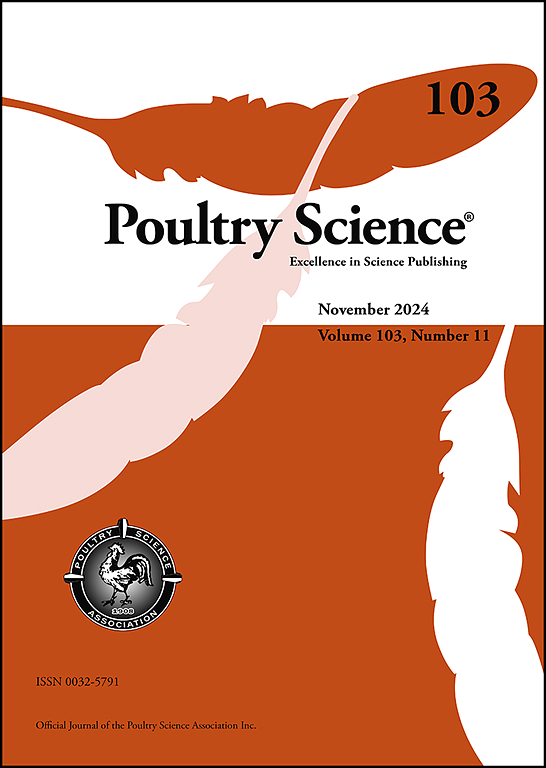Strict relationship between phenotypic and plasmid-associated genotypic of multidrug-resistant Escherichia coli isolated from Taihe Black-Boned Silky Fowl farms
IF 3.8
1区 农林科学
Q1 AGRICULTURE, DAIRY & ANIMAL SCIENCE
引用次数: 0
Abstract
Taihe Black-Boned Silky Fowl (TBSF) is a unique breed in China, characterized by a high concentration of melanin deposited throughout its body. Compared to broiler chickens, many antibiotics exhibit significantly longer withdrawal periods in TBSF. Given that antibiotic exposure is widely recognized as the primary selective pressure driving the persistence and dissemination of antibiotic resistance genes (ARGs) across diverse environments, it is crucial to investigate the occurrence and prevalence of ARGs within TBSF farming systems. In this study, 34 Escherichia coli strains isolated from 22 TBSF farms were subjected to phenotypic and genotypic analyses. The isolates were tested for susceptibility to 28 antimicrobial drugs representing nine antibiotic classes to determine their antimicrobial resistance phenotypes. Draft genome sequences of these E. coli strains were obtained, and the ARGs carried by mobile genetic elements, particularly plasmids, were analyzed for their association with susceptibility phenotype. The genetic context of key ARGs in these E. coli isolates was further characterized. Network analysis was employed to investigate the correlations between ARGs, phenotypes, and drug residues. The results demonstrated that high rates of antimicrobial resistance were observed, with 100 % and 29.4 % of isolates exhibiting resistance to four or more and eight or more antibiotic classes, respectively. According to whole-genome sequencing, a total of 143 ARGs were identified. The antimicrobial resistance phenotypes were consistently correlated with the presence of corresponding ARGs in the 34 E. coli genomes. 100 % of the β-lactams antibiotics resistant mechanism could be attributed to the presence of the resistance gene blaTEM and/or blaOXA-10. Similarly, resistance to tetracyclines, chloramphenicols, aminoglycosides, and fluoroquinolones was fully explained by the presence of tetR and/or tetA, floR and/or cmlA, ant(3’’)-IIa, aph(3’’)-Ib, aph(6)-Id, aac(3)-IId, and aadA, and qnrS and/or mutant gyrA/parC/mdtH. The majority of these key ARGs were found to be plasmid-associated. This study verified and highlighted the prevalent horizontal gene transfer of ARGs in TBSF farms. Factors such as hygiene status, biosecurity measures, and other environmental conditions might play a more significant role than antimicrobial usage in facilitating the horizontal gene transfer of ARGs in TBSF farms. Appropriate measures should be taken to control the transmission and dissemination of these mobile genetic elements associated ARGs and prevent their entry into the human clinical environment from TBSF breeding environment.
求助全文
约1分钟内获得全文
求助全文
来源期刊

Poultry Science
农林科学-奶制品与动物科学
CiteScore
7.60
自引率
15.90%
发文量
0
审稿时长
94 days
期刊介绍:
First self-published in 1921, Poultry Science is an internationally renowned monthly journal, known as the authoritative source for a broad range of poultry information and high-caliber research. The journal plays a pivotal role in the dissemination of preeminent poultry-related knowledge across all disciplines. As of January 2020, Poultry Science will become an Open Access journal with no subscription charges, meaning authors who publish here can make their research immediately, permanently, and freely accessible worldwide while retaining copyright to their work. Papers submitted for publication after October 1, 2019 will be published as Open Access papers.
An international journal, Poultry Science publishes original papers, research notes, symposium papers, and reviews of basic science as applied to poultry. This authoritative source of poultry information is consistently ranked by ISI Impact Factor as one of the top 10 agriculture, dairy and animal science journals to deliver high-caliber research. Currently it is the highest-ranked (by Impact Factor and Eigenfactor) journal dedicated to publishing poultry research. Subject areas include breeding, genetics, education, production, management, environment, health, behavior, welfare, immunology, molecular biology, metabolism, nutrition, physiology, reproduction, processing, and products.
 求助内容:
求助内容: 应助结果提醒方式:
应助结果提醒方式:


